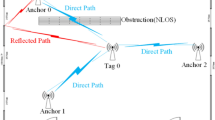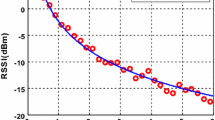Abstract
The dead reckoning (DR) is widely used for indoor positioning because it does not rely on external information, but it has the disadvantage of not being able to give an initial position and the problem of error accumulation. When the number of anchors is greater than two, the ranging-based multilateral positioning algorithm can provide the positioning position without accumulated error. However, in the practical application of indoor positioning, it is very costly to guarantee coverage with at least three anchor points at each location. In response to the shortcomings of the two indoor positioning methods mentioned above, this paper discusses for the first time how to effectively integrate single anchor and DR for indoor positioning, namely SADR. By combining the range information of a single anchor with the distance information of DR, SADR can not only provide the absolute position of the target to be located but also avoid the accumulation of positioning error and the need for more anchor coverage. The contribution of SADR mainly has two aspects: on the one hand, two specific initial positions and position refinement mathematical models are provided for the positioning problem proposed in this article; On the other hand, the existing least squares method and gradient descent method are used respectively to solve the above mathematical problems. The simulation results show that the average positioning error of SADR is about 1.4 m, the standard deviation of ranging and DR is 0.6 m, and 80% of the poslitioning error is less than 2.5 m.








Similar content being viewed by others
Availability of Data
All simulation data generated during this study are included in this published article and its supplementary information files.
References
Asaad, S. M., Potrus, M. Y., Ghafoor, K. Z., et al. (2022). Improving positioning accuracy using optimization approaches: A survey, research challenges and future perspectives. Wireless Personal Communications, 122, 3393–3409.
Li, M., Jiang, F., & Pei, C. (2020). Review on positioning technology of wireless sensor networks. Wireless Personal Communications, 115, 2023–2046.
Dong, J., Noreikis, M., Xiao, Y., et al. (2019). ViNav: A vision-based indoor navigation system for smartphones. IEEE Transactions on Mobile Computing, 18(6), 1461–1475.
Yang, Z., Pan, Y., Tian, Q., et al. (2019). Real-time infrastructureless indoor tracking for pedestrian using a smartphone. IEEE Sensors Journal, 19(22), 10782–10795.
Shao, S., Khreishah, A., & Khalil, I. (2020). Enabling real-time indoor tracking of IoT devices through visible light retroreflection. IEEE Transactions on Mobile Computing, 19(4), 836–851.
Li, L., Guo, X., Ansari, N., et al. (2019). A hybrid fingerprint quality evaluation model for WiFi localization. IEEE Internet of Things Journal, 6(6), 9829–9840.
Chiputa, M., & Xiangyang, L. (2018). Real time Wi-Fi indoor positioning system based on RSSI measurements: A distributed load approach with the fusion of three positioning algorithms. Wireless Personal Communications, 99, 67–83.
Krishnaveni, B. V., Reddy, K. S., & Reddy, P. R. (2022). Indoor tracking by adding IMU and UWB using Unscented Kalman filter. Wireless Personal Communications, 123, 3575–3596.
Tian, Q. L., Wang, K., & Salcic, Z. (2019). A low-cost INS and UWB fusion pedestrian tracking system. IEEE Sensors Journal, 19(10), 3733–3740.
Wang, K. S. (2014). Intelligent and integrated RFID (II-RFID) system for improving traceability in manufacturing. Advances in Manufacturing, 2, 106–120.
Ma, Y., Tian, C., & Jiang, Y. (2019). A multi-tag cooperative localization algorithm based on weighted multidimensional scaling for passive UHF RFID. IEEE Internet of Things Journal, 6(4), 6548–6555.
Luo, R. C., & Hsiao, T. J. (2019). Indoor localization system based on hybrid Wi-Fi/BLE and hierarchical topological fingerprinting approach. IEEE Transactions on Vehicular Technology, 68(11), 10791–10806.
Zhang, F. (2020). Fusion positioning algorithm of indoor WiFi and bluetooth based on discrete mathematical model. Journal of Ambient Intelligence and Humanized Computing, 11(11), 1–11.
Obeidat, H., Shuaieb, W., Obeidat, O., et al. (2021). A review of indoor localization techniques and wireless technologies. Wireless Personal Communications, 119, 289–327.
Lee, J., & Huang, S. (2019). An experimental heuristic approach to multi-pose pedestrian dead reckoning without using magnetometers for indoor localization. IEEE Sensors Journal, 19(20SI), 9532–9542.
Hasan, M. A., & Mishuk, M. N. (2018). Mems IMU based pedestrian indoor navigation for smart glass. Wireless Personal Communications, 101(1), 287–303.
Jiao, J., Deng, Z., Arain, Q. A., et al. (2021). Smart fusion of multi-sensor ubiquitous signals of mobile device for localization in GNSS-denied scenarios. Wireless Personal Communications, 116, 1507–1523.
Shi, Q., Xu, Q., & Zhang, J. (2019). An improved DV-Hop scheme based on path matching and particle swarm optimization algorithm. Wireless Personal Communications, 104, 1301–1320.
Huang, G., Hu, Z., Wu, J., et al. (2020). WiFi and vision-integrated fingerprint for smartphone-based self-localization in public indoor scenes. IEEE Internet of Things Journal, 7(8), 6748–6761.
Chen, L., Pei, L., Kuusniemi, H., et al. (2013). Bayesian fusion for indoor positioning using bluetooth fingerprints. Wireless Personal Communications, 70, 1735–1745.
Pei, L., Liu, D., Zou, D., et al. (2018). Optimal heading estimation based multidimensional particle filter for pedestrian indoor positioning. IEEE Access, 6(1), 49705–49720.
Tong, X., Su, Y., Li, Z., et al. (2020). A double-step unscented Kalman filter and HMM-Based zero-velocity update for pedestrian dead reckoning using MEMS sensors. IEEE Transactions on Industrial Electronics, 67(1), 581–591.
Manos, A., Klein, I., & Hazan, T. (2019). Gravity-based methods for heading computation in pedestrian dead reckoning. Sensors, 19(5), 1170–1189.
Ho, N.-H., Truong, P., et al. (2016). Step-detection and adaptive step-length estimation for pedestrian dead- reckoning at various walking speeds using a smartphone. Sensors, 16(9), 1423–1439.
Niu, X., Li, M., Cui, X., et al. (2014). WTrack: HMM-based walk pattern recognition and indoor pedestrian tracking using phone inertial sensors. Personal and Ubiquitous Computing, 18(8), 1901–1915.
Hasan, M. A., & Rahman, M. H. (2020). Smart phone based sensor fusion by using Madgwick filter for 3D indoor navigation. Wireless Personal Communications, 113(4), 2499–2517.
Wang, Q., Luo, H., Xiong, H., et al. (2021). Pedestrian dead reckoning based on walking pattern recognition and online magnetic fingerprint trajectory calibration. IEEE Internet of Things Journal, 8(3), 2011–2026.
Shi, L., Wang, Y., Liu, G., et al. (2018). A fusion algorithm of indoor positioning based on PDR and RSS fingerprint. IEEE Sensors Journal, 18(23), 9691–9698.
Chen, L., Wu, E. H., Jin, M., et al. (2014). Intelligent fusion of Wi-Fi and inertial sensor-based positioning systems for indoor pedestrian navigation. IEEE Sensors Journal, 14(11), 4034–4042.
Shi, L. F., He, R., & Feng, B. L. (2022). Indoor localization scheme using magnetic map for smartphones. Wireless Personal Communications, 122, 1329–1347.
Guo, S., Xiong, H., Zheng, X., et al. (2017). Activity recognition and semantic description for indoor mobile localization. Sensors, 17(3), 649.
Chen, H., Li, F., & Wang, Y. (2018). SoundMark: Accurate indoor localization via peer-assisted dead reckoning. IEEE Internet of Things Journal, 5(6), 4803–4815.
Zhou, W., & Zhang, S. (2015). The decision delay in finite-length MMSE–DFE systems. Wireless Personal Communications, 83(1), 175–189.
Mass-Sanchez, J., Ruiz-Ibarra, E., Cortez-González, J., et al. (2017). Weighted hyperbolic DV-hop positioning node localization algorithm in WSNs. Wireless Personal Communications, 96, 5011–5033.
Ansari, Z, Ghazizadeh, R., & Shokhmzan, Z. (2016). Gradient descent approach to secure localization for underwater wireless sensor networks. In 2016 24th Iranian conference on electrical engineering (ICEE) (pp. 103–107). IEEE.
Funding
The authors did not receive support from any organization for the submitted work.
Author information
Authors and Affiliations
Contributions
Methodology, algorithm presentation and writing-original draft were performed YY. Conceptualization, algorithm implementation, investigation were performed YL and YY, Performance evaluation, supervision and algorithm Validation were performed by ZL, WF and XX. All authors commented on previous versions of the manuscript and all authors read and approved the final manuscript.
Corresponding author
Ethics declarations
Conflicts of interest
The authors have no relevant financial or non-financial interests to disclose.
Additional information
Publisher's Note
Springer Nature remains neutral with regard to jurisdictional claims in published maps and institutional affiliations.
Rights and permissions
Springer Nature or its licensor (e.g. a society or other partner) holds exclusive rights to this article under a publishing agreement with the author(s) or other rightsholder(s); author self-archiving of the accepted manuscript version of this article is solely governed by the terms of such publishing agreement and applicable law.
About this article
Cite this article
Yao, Y., Liu, Y., Yao, Y. et al. SADR: A Single Anchor and Dead Reckoning Based Fusion Indoor Positioning Algorithm. Wireless Pers Commun 132, 719–736 (2023). https://doi.org/10.1007/s11277-023-10633-8
Accepted:
Published:
Issue Date:
DOI: https://doi.org/10.1007/s11277-023-10633-8




